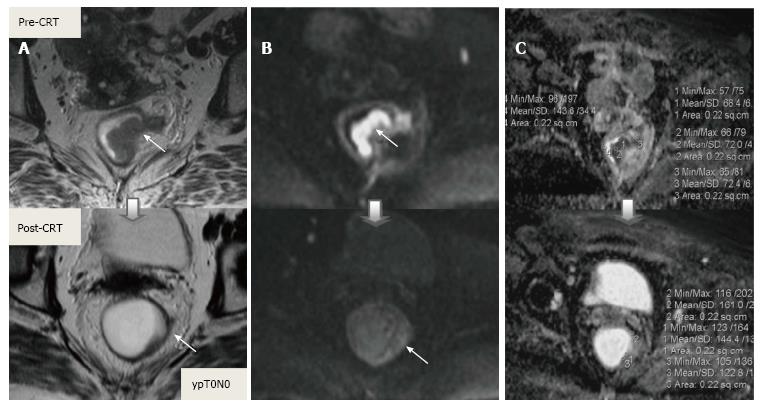Copyright
©The Author(s) 2017.
World J Clin Oncol. Jun 10, 2017; 8(3): 214-229
Published online Jun 10, 2017. doi: 10.5306/wjco.v8.i3.214
Published online Jun 10, 2017. doi: 10.5306/wjco.v8.i3.214
Figure 19 Post-chemoradiotherapy restaging using diffusion-weighted imaging in ypT0 rectal tumor.
On T2-weighted (A), DW (B) and ADC (C) images in the same patient, baseline and post-CRT images are shown on upper and lower series, respectively. A: Posttreatment T2-weighted axial image shows a thick wall of low-signal-intensity fibrosis in the previous rectal tumor area (arrow). It is difficult to determine whether this area contains tumor cells or completely devoid of tumor cells (complete response); B: On posttreatment DW image (B-800), there is no diffusion signal in previous tumor area (arrows), compatible with complete response. In this case, DWI allows the correct differentiation of viable tumor from fibrosis; C: ADC images show post-therapy mean ADC increase (0.70 × 10-3 mm²/s vs 1.40 × 10-3 mm²/s) compatible with therapy response, but does not allow prediction of complete response. DWI: Diffusion-weighted imaging; CRT: Chemoradiotherapy.
- Citation: Engin G, Sharifov R. Magnetic resonance imaging for diagnosis and neoadjuvant treatment evaluation in locally advanced rectal cancer: A pictorial review. World J Clin Oncol 2017; 8(3): 214-229
- URL: https://www.wjgnet.com/2218-4333/full/v8/i3/214.htm
- DOI: https://dx.doi.org/10.5306/wjco.v8.i3.214









